AMPLIFIER
CHASSIS FOR SALE.
March 2015.
I have a many amplifier chassis and metalwork parts which I will
never use. They were well made by CANFAB in 2003,
http://www.canfab.com.au
The quality is equal to anything made by hi-end hi-fi amp makers
anywhere in the world.
PRICE?
If you are thinking of building a pair of monobloc tube power amps
you may email me for a price for the metalwork
AND for the freight cost to your postcode. The chassis were meant
to be used for 4 different types of of monobloc amps
which I thought I may have to supply to customers. But nobody
wanted the possible amps and they all demanded something
different or "more unique."
The parts for 22 power amp monobloc chassis have been stored under
a bench for many years.
Each monobloc amp includes parts :-
1 pc main chassis with holes for tubes, ventilation.
2 pcs transformer pot,
1 pc perforated metal tube cover,
1 pc perforated metal bottom cover.
Below are some pictures of unpainted chassis ready to be filled
with parts for future amplifiers.
There are enough chassis for :-
2 monobloc SE amps, each with 1 x 13E1, 7big socket, 2
input/driver tubes.
2 monobloc SE/PP amps, each with 2 x 13E1, 7big socket. 3
input/driver tubes.
4 monobloc SE/PP amps, each with 2 x
6550/KT90KT88/EL34/6L6GC/300B.
4 monobloc SE/PP amps, each with 4 x
6550/KT90/KT88/KT120/EL34/6L6GC.
All dimensions = overall size in millimetres. To convert to inches
divide by 25.4.
The chassis are 1.6mm thick zinc plated steel sheet.
Transformer cases and perforated cages over tubes are 1.2mm zinc
plated steel sheet. All external corners are welded
and ground smooth to give an excellent finish for powder coating.
Type no 1 x 13EI.
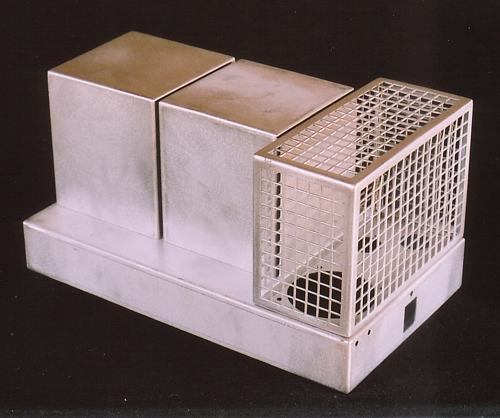
This one is for 1 x 13EI or other single tube which may fit.
Driver and input tube = 2 x octal or 9 pin miniature tubes.
Size of chassis = 360L x 210W x 55H
Size of transformer box = 125L x 125W x 140H, allows 70S x 44T
E&I core.
Size of cage = 204L x 96W x 140H.
Type no 2x13EI.
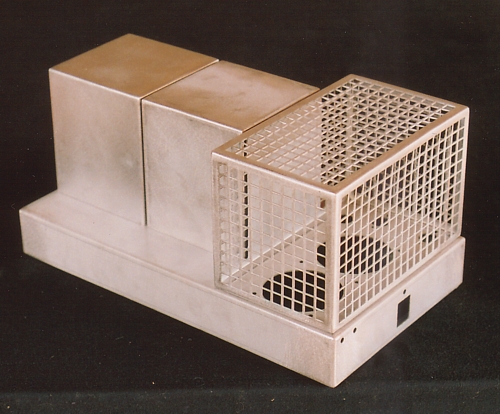
This one is for 2 x 13EI output tubes or other such as 300B etc.
Driver tube and input = 3 x mini nine pin.
Size of chassis = 400L x 230W x 55H.
Size of transformer box = 125L x 125W x 140H, allows 70S x 44T
E&I core.
Size of cage = 224L x 136W x 140H.
Type no 2 x Octal.
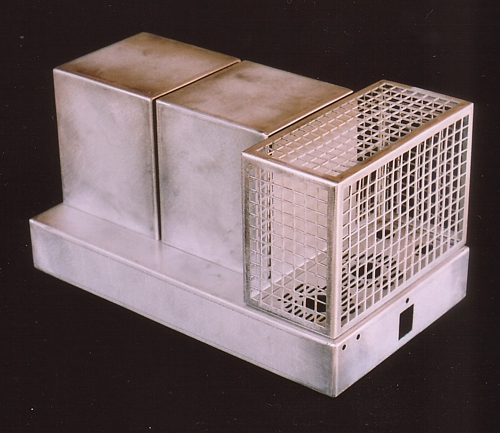
This one is for 2 x Octal output tubes.
Driver tube and input = 2 x miniature nine pin, or can be enlarged
for octal.
Size of chassis = 360L x 210W x 55H.
Size of transformer box = 125L x 125W x 140H, allows 70S x 44T
E&I core.
Size of cage = 204L x 96W x 140H.
Type no 4xOctal.
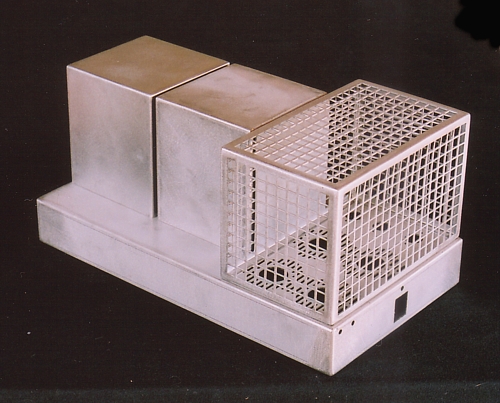
This one is for 4 x Octal output tubes. Driver tube and input = 3
x mini nine pin.
Size of chassis = 400L x 230W x 55H.
Size of transformer box = 125L x 125W x 140H, allows 70S x 44T
E&I core.
Size of cage = 224L x 136W x 140H.
Typical details of chassis cut-outs :-
2 x Octal, 4 and 2 x Octal chassis :-
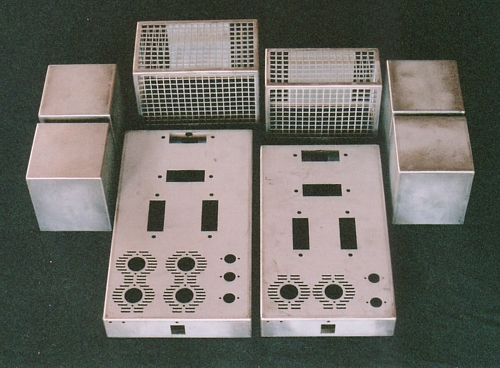
The large slots where transformers are mounted allow for the
primary and secondary terminals to be
mounted in fibreglass boards to project into the sub-chassis area
for easy wiring to tubes and for easy strapping
of secondary windings to suit different speaker loads.
The E&I laminations are vertically mounted and the clamp yokes
bolt to the chassis through each hole near each
end of the the chassis slots. The laminations are kept slightly
clear of the steel sheet chassis material.
Slots around the octal socket holes allow for cooling air flow up
around each output tube but not allowing objects
less than 3mm dimension to fall through the slots.
Not shown are the 2mm steel plate transformer yokes and steel
bottom plates with a large area perforated for ventilation.
1 and 2 x 13EI chassis :-
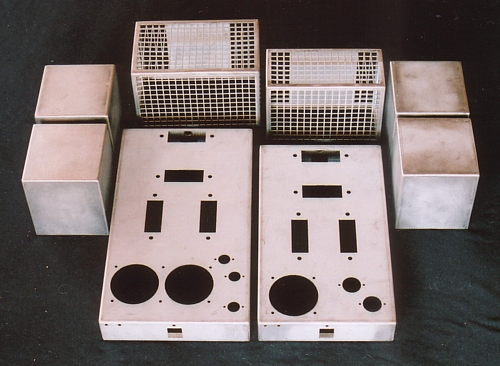
The large slots where transformers are mounted allow for the
primary and secondary terminals to be mounted
in fibreglass boards to project into the sub-chassis area for easy
wiring to tubes and for easy strapping of
secondary windings to suit different speaker loads.
The E&I laminations are vertically mounted and the clamp yokes
bolt to the chassis through each hole near
each end of the the chassis slots. The laminations are kept
slightly clear of the steel sheet chassis material.
The large 75mm dia holes for output tubes allow for small metal
plate about 80mm x 80mm to be mounted
say 25mm below the chassis top and which has a hole suitable hold
a 7big socket for 13E1, or other large
output tube, perhaps 6C33C, GM70, or KT120/150.
The small sub-chassis plate allows a generous air flow up around a
large output tube.
Not shown are the 2mm steel plate transformer yokes, steel bottom
plates with a large area perforated for ventilation
and sub-chassis plates for mounting 13E1 sockets.
Chassis for preamps.
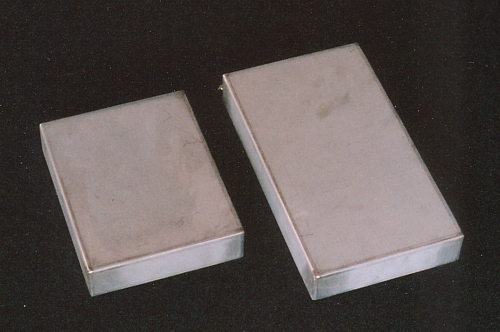
The preamp chassis are without any holes.
A small number are available.
The all-steel metalwork would need a considerable number of
additional holes to be drilled tapped for M3
or M4 c/s machine screws. For mass production, powder coating is
normally done to multiple chassis
after ALL holes and threads have been cut and all hole edges have
been de-burred and all oil cleaned off,
and surfaces sanded again by hand.
But for DIYers who want to make only 2 amps, they may have chassis
powder coated before the
additional holes and threads are cut. This involves more care with
c/s holes.
Painted or powder coated chassis should be covered in 2+ layers of
masking tape during assembly and work
on bench.
Mistakes with hole positions or hole sizes or blemishes cannot
easily be repaired.
Radical changes to design as you progress cannot be accommodated.
DIY hobbyists will make terrible mistakes
because of their lack of experience. I was a very patient and
thoughtful craftsman who took time to set out the hole
drilling so that the prototype amps I made became the finished amp
which I sold. The chassis have room for any
typical amp schematic I have at this website. The chassis were not
powder coated by CANFAB because not
everyone wanted black amps. Well done powder coating is cheaper
and harder than any automotive spray paint
or applied by asian amp makers. While chrome plating is possible,
I don't like it. Seeing samples of old chrome
plated amplifiers ( EAR509 ) led me to believe chrome is prone to
peeling, cracking and blemishes.
Back to Index Page






